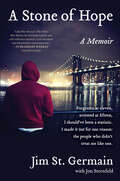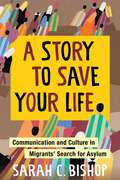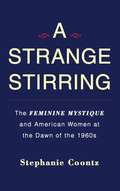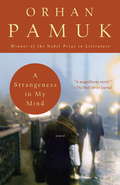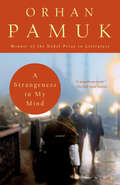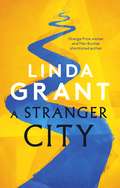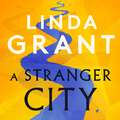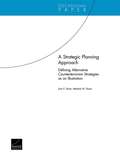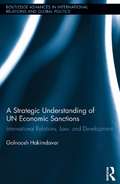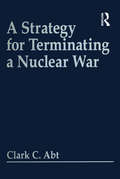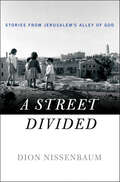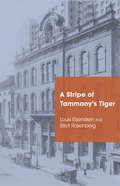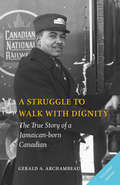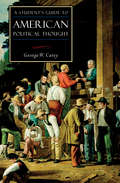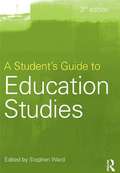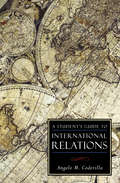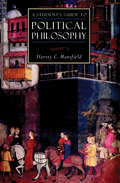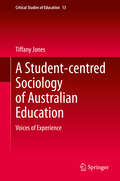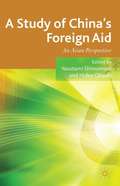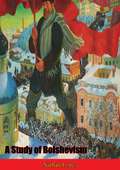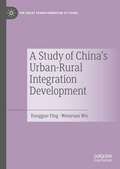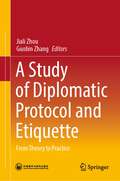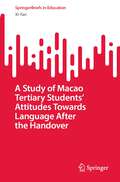- Table View
- List View
A Stone of Hope: A Memoir
by Jon Sternfeld Jim St. GermainIn the tradition of The Other Wes Moore and Just Mercy, a searing memoir and clarion call to save our at-risk youth by a young black man who himself was a lost cause—until he landed in a rehabilitation program that saved his life and gave him purpose.Born into abject poverty in Haiti, young Jim St. Germain moved to Brooklyn’s Crown Heights, into an overcrowded apartment with his family. He quickly adapted to street life and began stealing, dealing drugs, and growing increasingly indifferent to despair and violence. By the time he was arrested for dealing crack cocaine, he had been handcuffed more than a dozen times. At the age of fifteen the walls of the system were closing around him.But instead of prison, St. Germain was placed in "Boys Town," a nonsecure detention facility designed for rehabilitation. Surrounded by mentors and positive male authority who enforced a system based on structure and privileges rather than intimidation and punishment, St. Germain slowly found his way, eventually getting his GED and graduating from college. Then he made the bravest decision of his life: to live, as an adult, in the projects where he had lost himself, and to work to reform the way the criminal justice system treats at-risk youth.A Stone of Hope is more than an incredible coming-of-age story; told with a degree of candor that requires the deepest courage, it is also a rallying cry. No one is who they are going to be—or capable of being—at sixteen. St. Germain is living proof of this. He contends that we must work to build a world in which we do not give up on a swath of the next generation.Passionate, eloquent, and timely, illustrated with photographs throughout, A Stone of Hope is an inspiring challenge for every American, and is certain to spark debate nationwide.
A Story to Save Your Life: Communication and Culture in Migrants' Search for Asylum
by Sarah BishopA young woman flees violence in Mexico and seeks protection in the United States—only to be trafficked as a domestic worker in the Bronx. A decorated immigration judge leaves his post when the policies he proudly upheld capsize in the wake of political turmoil. A Gambian translator who was granted asylum herself talks with other African women about how immigration officers expect victims of torture to behave. A border patrol officer begins to question the training that instructs him to treat the children he finds in the Arizona desert like criminals.Through these and other powerful firsthand accounts, A Story to Save Your Life offers new insight into the harrowing realities of seeking protection in the United States. Sarah C. Bishop argues that cultural differences in communication shape every stage of the asylum process, playing a major but unexamined role. Migrants fleeing persecution must reconstruct the details of their lives so governmental authorities can determine whether their experiences justify protection. However, Bishop shows, many factors influence whether an applicant is perceived as credible, from the effects of trauma on the ability to recount an experience chronologically to culturally rooted nonverbal behaviors and displays of emotion. For asylum seekers, harnessing the power of autobiographical storytelling can mean the difference between life and death. A Story to Save Your Life emphasizes how memory, communication, and culture intertwine in migrants’ search for safety.
A Strange Stirring: The Feminine Mystique and American Women at the Dawn of the 1960s
by Stephanie CoontzIn 1963, Betty Friedan unleashed a storm of controversy with her bestselling book, The Feminine Mystique. Hundreds of women wrote to her to say that the book had transformed, even saved, their lives. Nearly half a century later, many women still recall where they were when they first read it. In A Strange Stirring, historian Stephanie Coontz examines the dawn of the 1960s, when the sexual revolution had barely begun, newspapers advertised for "perky, attractive gal typists," but married women were told to stay home, and husbands controlled almost every aspect of family life. Based on exhaustive research and interviews, and challenging both conservative and liberal myths about Friedan, A Strange Stirring brilliantly illuminates how a generation of women came to realize that their dissatisfaction with domestic life didn't reflect their personal weakness but rather a social and political injustice.
A Strangeness in My Mind
by Orhan PamukFrom one of our greatest, a panoramic new novel, his first since Museum of Innocence, bringing us into Istanbul's underground through the eyes of a struggling street vendor. Mevlut, an Istanbul street vendor, has spent his whole life selling a local alcoholic drink. It is the 1990s, and although there were once thousands of boza vendors walking the frozen streets of the city, Mevlut now cuts a lonely figure on snowy winter nights. Falling deeply into debt, and desperate to marry off his incompetent son and satisfy his mistress, Mevlut turns to his old friend Ferhat, who collects payments on electric bills. The partners traverse the back streets of middle class neighbourhoods and shantytowns, venture into flats, shops and restaurants of the poor, relishing their power to punish cheaters and collect bribes. The dangers of Instanbul's underbelly eventually catch up with Mevlut, and he is attacked by a pack of dogs, hospitalized, robbed by bandits and beaten and threatened at every turn. Istanbul is exposed as a city with a rich and dynamic underground culture which seeps into its secular business centres and mainstream society. Mevlut serves as a flighty guide, occasionally attuned to the city's nuances, but with a wild imagination and insticts tainted by desperation.
A Strangeness in my Mind: A novel (Vintage International)
by Orhan Pamuk Ekin OklapFrom the Nobel Prize winner and best-selling author of Snow and My Name Is Red: a soaring, panoramic new novel—his first since The Museum of Innocence—telling the unforgettable tale of an Istanbul street vendor and the love of his life. Since his boyhood in a poor village in Central Anatolia, Mevlut Karataş has fantasized about what his life would become. Not getting as far in school as he’d hoped, at the age of twelve he comes to Istanbul—“the center of the world”—and is immediately enthralled by both the old city that is disappearing and the new one that is fast being built. He follows his father’s trade, selling boza (a traditional mildly alcoholic Turkish drink) on the street, and hoping to become rich, like other villagers who have settled the desolate hills outside the booming metropolis. But luck never seems to be on Mevlut’s side. As he watches his relations settle down and make their fortunes, he spends three years writing love letters to a girl he saw just once at a wedding, only to elope by mistake with her sister. And though he grows to cherish his wife and the family they have, he stumbles toward middle age in a series of jobs leading nowhere. His sense of missing something leads him sometimes to the politics of his friends and intermittently to the teachings of a charismatic religious guide. But every evening, without fail, Mevlut still wanders the streets of Istanbul, selling boza and wondering at the “strangeness” in his mind, the sensation that makes him feel different from everyone else, until fortune conspires once more to let him understand at last what it is he has always yearned for.Told from different perspectives by a host of beguiling characters, A Strangeness in My Mind is a modern epic of coming of age in a great city, a brilliant tableau of life among the newcomers who have changed the face of Istanbul over the past fifty years. Here is a mesmerizing story of human longing, sure to take its place among Pamuk’s finest achievements.
A Stranger City
by Linda GrantWINNER OF THE WINGATE LITERARY PRIZE 2020 `A superb piece of writing about London life. Past Wingate winners include Zadie Smith, Amos Oz and David Grossman' '[A] shimmering new novel . . . Grant's book is as much a love letter to London as a lament, an ode to pink skin after sunny days and lost gloves waving from railings' The Economist'A compelling portrait of contemporary London, it's a novel fit for shifting, uncertain times' Suzi Feay, Financial Times'A Stranger City feels like a very important novel for right now: no politically ponderous diatribe but a witty, sunlounger-accessible and deeply humanising story about people - about us - and the societal shipwreck we're stuck in' Evening StandardWhen a dead body is found in the Thames, caught in the chains of HMS Belfast, it begins a search for a missing woman and confirms a sense that in London a person can become invisible once outside their community - and that assumes they even have a community. A policeman, a documentary film-maker and an Irish nurse named Chrissie all respond to the death of the unknown woman in their own ways. London is a place of random meetings, shifting relationships - and some, like Chrissie intersect with many. The film-maker and the policeman meanwhile have safe homes with wives - or do they? An immigrant family speaks their own language only privately; they have managed to integrate - or have they? The wonderful Linda Grant weaves a tale around ideas of home; how London can be a place of exile or expulsion, how home can be a physical place or an idea. How all our lives intersect and how coincidence or the randomness of birth place can decide how we live and with whom.
A Stranger City
by Linda GrantWINNER OF THE WINGATE LITERARY PRIZE 2020 `A superb piece of writing about London life. Past Wingate winners include Zadie Smith, Amos Oz and David Grossman' '[A] shimmering new novel . . . Grant's book is as much a love letter to London as a lament, an ode to pink skin after sunny days and lost gloves waving from railings' The Economist'A compelling portrait of contemporary London, it's a novel fit for shifting, uncertain times' Suzi Feay, Financial Times'A Stranger City feels like a very important novel for right now: no politically ponderous diatribe but a witty, sunlounger-accessible and deeply humanising story about people - about us - and the societal shipwreck we're stuck in' Evening StandardWhen a dead body is found in the Thames, caught in the chains of HMS Belfast, it begins a search for a missing woman and confirms a sense that in London a person can become invisible once outside their community - and that assumes they even have a community. A policeman, a documentary film-maker and an Irish nurse named Chrissie all respond to the death of the unknown woman in their own ways. London is a place of random meetings, shifting relationships - and some, like Chrissie intersect with many. The film-maker and the policeman meanwhile have safe homes with wives - or do they? An immigrant family speaks their own language only privately; they have managed to integrate - or have they? The wonderful Linda Grant weaves a tale around ideas of home; how London can be a place of exile or expulsion, how home can be a physical place or an idea. How all our lives intersect and how coincidence or the randomness of birth place can decide how we live and with whom.
A Strategic Planning Approach
by Lynn E. Davis Melanie W. SissonWhile the United States government has historically undertaken strategic reviews and produced numerous strategy documents, these have provided only very general directions for U.S. policymakers. This paper defines an approach to strategic planning and illustrates its application using the example of the critical national security topic of counterterrorism.
A Strategic Understanding of UN Economic Sanctions: International Relations, Law and Development (Routledge Advances in International Relations and Global Politics)
by Golnoosh HakimdavarEconomic Sanctions are increasingly used as a legal, non-military technique of combating abusers of international peace. However it remains unclear how the success or failure of these sanctions is measured. This book examines the seldom-explored United Nations’ economic sanctions deliberation process and exposes systematic problems in the measurement of the success or failure of these sanctions. Centering on the key concepts of "peace and security," the author brings the reader’s attention to the discrepancies that exist in the process of decision-making, implementation, and evaluation of UN imposed economic sanctions. She engages international law and development methods to provide proof for the lack of consensus in measures of success and failure, which in turn suggests that sanction implementation on a uniform domestic front are unattainable. This thorough analysis concludes with suggestions for improving the sanctions process, only to clear the path for negating them as a whole and suggest alternative non-coercive measures for mitigating conflict situations and threats to peace and security.
A Strategic Vision: For Department Of Energy Environmental Quality Research And Development
by National Research CouncilThe National Academies Press (NAP)--publisher for the National Academies--publishes more than 200 books a year offering the most authoritative views, definitive information, and groundbreaking recommendations on a wide range of topics in science, engineering, and health. Our books are unique in that they are authored by the nation's leading experts in every scientific field.
A Strategy For Terminating A Nuclear War
by Clark C AbtAvoiding a nuclear war, or ending one if avoidance fails, is an important but relatively unexplored aspect of nuclear doctrine. Dr. Abt examines the feasibility of antagonists' agreeing to exclude their open cities from nuclear targeting and to replace strategic bombardment with retaliatory invasion to create less of a hair[1]trigger deterrent. Critical net assessments by U.S. strategists and the effects of such a strategy on the Soviet Union and on U.S. allies are considered, along with problems implementation might pose. The author contends that both deterrence and the potential for limiting damage are strengthened by pre-war plans for a nuclear ceasefire and stalemate short of holocaust.
A Street Divided: Stories from Jerusalem's Alley of God
by Dion NissenbaumIt has been the home to priests and prostitutes, poets and spies. It has been the stage for an improbable flirtation between an Israeli girl and a Palestinian boy living on opposite sides of the barbed wire that separated enemy nations. It has even been the scene of an unsolved international murder. This one-time shepherd's path between Jerusalem and Bethlehem has been a dividing line for decades. Arab families called it "al Mantiqa Haram." Jewish residents knew it as "shetach hefker." In both languages, in both Israel and Jordan, it meant the same thing: "the Forbidden Area." Peacekeepers that monitored the steep fault line dubbed it "Barbed Wire Alley." To folks on either side of the border, it was the same thing: A dangerous no-man's land separating warring nations and feuding cultures in the Middle East. The barbed wire came down in 1967. But it was soon supplanted by evermore formidable cultural, emotional and political barriers separating Arab and Jew.For nearly two decades, coils of barbed wire ran right down the middle of what became Assael Street, marking the fissure between Israeli-controlled West Jerusalem and Jordanian-controlled East Jerusalem. In a beautiful narrative, Dion Nissenbaum's A Street Divided offers a more intimate look at one road at the heart of the conflict, where inches really do matter.
A Stripe Of Tammany's Tiger
by Louis Eisenstein Elliot Rosenberg"This book is a highly personal glimpse into the world of precinct, district, and county politics. It deals with several stripes of the Tammany Tiger and brings into close focus some of the most forceful background figures in New York City's political framework. Primarily, it is a forty-year panorama of Tammany practices and personalities."—from A Stripe of Tammany’s Tiger In this fascinating book, first published in 1966, Louis Eisenstein, a Tammany precinct captain from Manhattan’s Lower East Side, sets out with his coauthor Elliot Rosenberg to chronicle the evolution—or rather devolution—of New York City politics through the first seven decades of the twentieth century. Eisenstein imbues his lively narrative with an overarching theme: that personal interactions and good faith between those at all levels of power are of paramount importance both for sustained political success and for competent municipal administration.
A Struggle to Walk With Dignity: The True Story of a Jamaican-born Canadian
by Gerald A. ArchambeauGerald Augustus Archambeau was born in Jamaica in 1933. Raised in Kingston by his three aunts, he was sent to Canada in 1947 to join his mother and stepfather in Montreal. He trained in the plumbing and steam-fitting trade, but at age eighteen decided to join the railway as a passenger car porter. He worked for Canadian Pacific and Canadian National until the 1960s, when declining passenger rail traffic and the ascendence of air travel caused him to switch to a career with a major Canadian airline in Toronto. After his retirement from the airline, Gerald and his wife, Marion, settled in St. Catharines, Ontario.
A Student's Guide to American Political Thought (ISI Guides to the Major Disciplines)
by George W. CareyA concise overview of the competing political philosophies that have shaped United States history. Who are the most influential thinkers, and which are the most important concepts, events, and documents in the study of the American political tradition? How ought we regard the beliefs and motivations of the founders, the debate over the ratification of the Constitution, the historical circumstances of the Declaration of Independence, the rise of the modern presidency, and the advent of judicial supremacy? These are a few of the fascinating questions canvassed by George W. Carey in A Student&’s Guide to American Political Thought. Carey&’s primer instructs students on the fundamental matters of American political theory while telling them where to turn to obtain a better grasp on the ideas that have shaped the American political heritage.
A Student's Guide to Education Studies
by Stephen WardA Student’s Guide to Education Studies is a much-needed resource for any undergraduate making their first explorations into the fascinating world of education. The first publication of this book in 2002 helped to define the nature of the subject, introducing topics into the field which had not been previously considered. This new edition brings the subject up to date with the latest thinking and research on policy, globalisation, learning and knowledge,?offering an accessible and wide-ranging introduction to a diverse range of topics and issues in education. Now fully updated to reflect rapid and significant changes in the field, this third edition considers topical issues including: the political dimension of education, the national debate about schooling and poverty, the marketisation of education, the end of Every Child Matters, the Coalition Government’s policies for academies and free schools.? Organised around three enduring themes - Education Policy and Politics, Global and Environmental Education, and Learning, Knowledge and the Curriculum - each chapter contains summary points, questions for discussion, and annotated suggestions for further reading. With a distinctive international and global focus, A Student's Guide to Education Studies is an essential resource for all students of Education Studies.
A Student's Guide to International Relations (ISI Guides to the Major Disciplines #4)
by Angelo M. CodevillaA concise journey through geopolitics and the continuing debate about America&’s role in the world. Terrorist attacks, wars in Afghanistan and Iraq, the rise of China, and the decline of Europe have underscored the necessity of understanding the world around us. But how should we approach this crucial but often misunderstood topic? What do we need to know about the international order and America&’s role in it?A Student&’s Guide to International Relations provides a vital introduction to the geography, culture, and politics that make up the global environment. Angelo Codevilla, who has taught international relations at some of America&’s most prestigious universities, explains the history of the international system, the dominant schools of American statecraft, the instruments of power, contemporary geopolitics, and more. The content of international relations, he demonstrates, flows from the differences between our global village&’s peculiar neighborhoods. This witty and wise book helps make sense of a complex world.
A Student's Guide to Political Philosophy (ISI Guides to the Major Disciplines)
by Harvey C. MansfieldA primer on the bedrock principles of politics from &“Harvard&’s most controversial conservative professor&” and the author of Democracy in America (Boston magazine). Behind the daily headlines on presidential races and local elections is the theory of the polity—or what the end of our politics should be. Harvard&’s Harvey C. Mansfield, one of America&’s leading political theorists, explains why our quest for the good life must address the type of government we seek to uphold. He directs our gaze to the thinkers and philosophies and classic works that have proved most influential throughout the ages.
A Student-centred Sociology of Australian Education: Voices of Experience (Critical Studies of Education #13)
by Tiffany JonesThis book is based on a comparative study from 2018, of four different approaches to education, according to 2,500 Australians’ experiences of them, on a range of topics. It shows that whilst the critical approach has strong research-based support across the board, sometimes a liberal, conservative or post-modern approach may have some merit for certain outcomes. This is a book about challenging our biases and calling on ourselves to aim higher for education, than what our own pre-conceived ideas might allow. What and who is valued in education, and the social roles and identity messages learned, differ wildly from school to school. Education is most impacted by the orientation of education dominant in that context – whether conservative, liberal, critical or post-modern. These terms are often used with little practical data on the real-life schooling they entail. Who learns what in which approach? Who learns best with which approach, on which topic and why? This book provides this previously missing information. It offers holistic, detailed descriptions of conservative, liberal, critical and post-modern approaches to education broadly. It provides statistics and stories from real students on how the four approaches work practically in schools in relation to: age, gender, sexuality, social class, race, news-media, popular culture and technology. Chapters offer background information to the four perspectives, data from student participants, tutorial questions and activities, and suggestions for further reading.
A Study Of China’s Foreign Aid
by Yasutami Shimomura Hideo OhashiThis book provides a new perspective of China's controversial foreign aid strategy. The chapters offer a thorough examination of data to show how China has created knowledge in its long experiences of aid and how this accumulated knowledge could contribute to other developing countries. The book also examines China's aid philosophy and strategy through an Asian perspective, instead of the Western perspective that is postulated in existing academic literature. This is important as China shares a number of common features with other Asian donors, including India and Japan. Finally, the book explores how to utilize the potential effect of this rising major donor for worldwide development and poverty reduction.
A Study of Bolshevism
by Nathan LeitesA massive effort to determine the objectives and techniques of Soviet communism by intensive examination of all the works of Lenin and Stalin.“In this book I shall attempt to portray the spirit of the Bolshevik elite—the elite which in 1903 had a dominant influence on a few hundred members of the Russian Social-Democratic Workers’ Party, and today influences several hundred million people in Europe, Asia and elsewhere.In doing so, I have a two-fold objective: to contribute to our knowledge of the varieties of man; and to enhance the skill of Western policy-makers in dealing with the Politburos of the Soviet and other Communist parties. There are various ways to study the spirit of a ruling group. Here I have chosen just one: the analysis of its doctrine. It is conceivable that future researches will show other procedures to be equally, or more, productive.I do not propose to analyze Bolshevik doctrine as fully as possible, but rather to take one aspect of it: what I call the operational code, that is, the conceptions of political “strategy.” Future research may deal in a comparable manner with other aspects of Bolshevik ideology. We cannot now prejudge the relation, and relevance, of the results to be obtained by such different foci of study.” - Author’s introduction
A Study of China's Urban-Rural Integration Development (The Great Transformation of China)
by Wenyuan Wu Dangguo YingChina's urbanization has stunned the world in the past two decades- but as the authors of this book explain, the growth is only set to continue. The divide between urban and rural citizens in China implicates every aspect of Chinese life, from education to pollution to healthcare. In this book, one of China's most celebrated academic urbanists and a major urban planner collaborate in laying out and analyzing the problems of China's urban-rural divide, experiences of urbanization, and what the future holds. This book is a must read, not only for the accurate summaries of China's developmental experience it includes, but also for the insights it provides into the mentalities of the government officials and private developers who are creating realities on the ground in Chinese cities.
A Study of Diplomatic Protocol and Etiquette: From Theory to Practice
by Jiali Zhou Guobin ZhangThis book, with its focus on the study of diplomatic protocol and etiquette, collects high-quality papers written by scholars in diplomatic protocol from nine countries, including US, UK, Russia, Japan, Canada, Netherlands, India and China. As a result of in-depth international academic cooperation, it explores diplomatic protocol from three dimensions of theory, practice and country-specific and has the characteristics of internationality and nationality. From a global perspective, it is the first time that experts from so many countries work together in diplomatic protocol which makes this book present a more comprehensive and diverse overview. This book, as an effort made to enhance understanding among different cultures and facilitate the harmonious coexistence of people across the world, is remarkably helpful for promoting the research of diplomatic protocol and etiquette, exploring the true connotation of protocol and etiquette, and improving its practicality in realities.
A Study of Macao Tertiary Students’ Attitudes Towards Language After the Handover (SpringerBriefs in Education)
by Xi YanThis book focuses on the attitudes of Macao tertiary students toward language after the handover. It shares the findings of a questionnaire survey and semi-structured interviews, which were conducted among freshmen of the University of Macao to investigate their attitudes toward Cantonese, Putonghua, English, and Portuguese, as well as their attitudes toward Macao's language planning and language policy. Utilizing a multidimensional and multilayered perspective in the study, this book also demonstrates the orientations of Macao tertiary students and the correlation between their social categories (gender and social class) and their attitudes toward language.
A Study of the Principles of Politics: Being an Essay Towards Political Rationalization (Routledge Library Editions: Political Thought and Political Philosophy #11)
by George E. CatlinOriginally published in 1930, this title brings to its conclusion a work first published, in part, in the earlier volume The Science and Method of Politics. The work was undertaken at first with a view to discovering the forces at work which form the anatomy and determine the physiology of States. However, it became apparent that not States but Society must be the object of study if any progress were to made, and if the inquiry were to be radical enough to disclose, and indicate the means of controlling, the causes which conduce to such social disorders as war. The subject might very well have been treated from a very different point of view. However, the author felt that the approach to politics from the angle of political philosophy and the humanities was less important for the needs of the time than an approach from the angle of psychology and of statistics.
